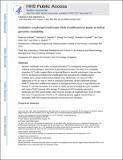Oxidation of phosphorothioate DNA modifications leads to lethal genomic instability
Author(s)
You, Delin; Kellner, Stefanie M; DeMott, Michael S; Cheng, Ching Pin; Russell, Brandon S; Cao, Bo; Dedon, Peter C; ... Show more Show less
Downloadnihms864512.pdf (794.2Kb)
PUBLISHER_POLICY
Publisher Policy
Article is made available in accordance with the publisher's policy and may be subject to US copyright law. Please refer to the publisher's site for terms of use.
Terms of use
Metadata
Show full item recordAbstract
Genomic modification by sulfur in the form of phosphorothioate (PT) is widespread among prokaryotes, including human pathogens. Apart from its physiological functions, PT sulfur has redox and nucleophilic properties that suggest effects on bacterial fitness in stressful environments. Here we show that PTs are dynamic and labile DNA modifications that cause genomic instability during oxidative stress. In experiments involving isotopic labeling coupled with mass spectrometry, we observed sulfur replacement in PTs at a rate of ∼2% h-1in unstressed Escherichia coli and Salmonella enterica. Whereas PT levels were unaffected by exposure to hydrogen peroxide (H2O2) or hypochlorous acid (HOCl), PT turnover increased to 3.8-10% h1after HOCl treatment and was unchanged by H2O2, consistent with the repair of HOCl-induced sulfur damage. PT-dependent sensitivity to HOCl extended to cytotoxicity and DNA strand breaks, which occurred at HOCl doses that were orders of magnitude lower than the corresponding doses of H2O2. The genotoxicity of HOCl in PT-containing bacteria suggests reduced fitness in competition with HOCl-producing organisms and during infections in humans.
Date issued
2017-06Department
Massachusetts Institute of Technology. Department of Biological EngineeringJournal
Nature Chemical Biology
Publisher
Nature Publishing Group
Citation
Kellner, Stefanie et al. “Oxidation of Phosphorothioate DNA Modifications Leads to Lethal Genomic Instability.” Nature Chemical Biology 13, 8 (June 2017): 888–894 © 2017 Nature Publishing Group
Version: Author's final manuscript
ISSN
1552-4450
1552-4469